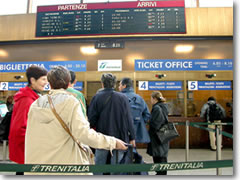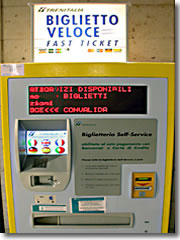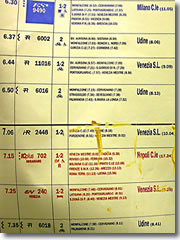Train tickets & reservations in Europe
Unless you go ticketless with a railpass, you'll have to buy train tickets as you go in Europe
 As you can see from this ticket line in Trieste, Italy, most European train stations have English-language signs. As for the bits that are in local lingo—like that big arrivals and departures board above the ticket windows—use common sense. "Arrivi" must be arrivals, which makes "partenze" the departures side.
As you can see from this ticket line in Trieste, Italy, most European train stations have English-language signs. As for the bits that are in local lingo—like that big arrivals and departures board above the ticket windows—use common sense. "Arrivi" must be arrivals, which makes "partenze" the departures side.
This is fairly straightforward exercise, but be warned: lines at ticket windows can be long and the wait even longer. Get to the station at least 30 minutes early, more if you can manage it.
Even better, pop by the station a day or two before you plan to leave and go ahead and buy your ticket in advance ; it'll save you from headaches later, and ensure you at least won't miss your train because you were standing in an interminable line waiting to buy the tix.
Luckily, over the past decade automated ticket machines have been springing up in most major European stations—and, more importantly, over the past few years they've finally started working properly and are no longer eternally out of order.
 Automated ticket machines are popping up even in small stations all across Europe. They are certainly time-savers—though one or two folks might be in front of you to use it, the line goes way faster than the interminable queue at a manned ticket window—plus they let you examine all the different departure times and routes at your leisure. As you can see, they even accept Visa and MasterCard.
Automated ticket machines are popping up even in small stations all across Europe. They are certainly time-savers—though one or two folks might be in front of you to use it, the line goes way faster than the interminable queue at a manned ticket window—plus they let you examine all the different departure times and routes at your leisure. As you can see, they even accept Visa and MasterCard.
These machines employ keyboards and touch screens, so using one is as easy as typing in your destination, tapping on the departure time you want, then slipping in some banknotes or your credit card, and grabbing the printed ticket from the slot at the bottom.
Or you can wait in line for half an hour.
For more on the train station and its services including buying tickets, see the Train Stations page. All of this can be done within minutes of boarding the train—usually.
Whether or not you should set your travel plans in stone by reserving ahead is up to you. Here are my arguments.
To Reserve or Not to Reserve?
Reservations are required on some of the speediest of the high-speed runs, including Eurostar (the Channel Tunnel train from London to Paris or Brussels), TGV in France, ETR/Pendolino in Italy, and long-distance trains in Spain.
I would also reserve any sleeping berths or couchettes because there's nothing worse than trying to sleep sitting up all night.
Any train marked with an R on a schedule needs to be reserved ahead of time for a fee ranging from $10 up beyond $50 (the latter when a meal is included).
 A close-up of the "departures" poster in the Trieste train station. The left column shows departure times, the next one the type of line (R for regional, iR for inter-regional, IC for InterCity, EN for EuroNight, and ES for EuroStar) and the train number. The third column tells you which trains have both first- and second-class cars and which just second-class, whether you can bring bikes on board, if sleeper cars are available (as is the case with the 7:25 to Venice), and—most importantly—an 'R" to indicate on which trains a reservation is required (here, on the 6:20 to Milano, and the 7:15 to Napoli/Naples). For more on how to decipher this poster, see the "European Train System" page.
A close-up of the "departures" poster in the Trieste train station. The left column shows departure times, the next one the type of line (R for regional, iR for inter-regional, IC for InterCity, EN for EuroNight, and ES for EuroStar) and the train number. The third column tells you which trains have both first- and second-class cars and which just second-class, whether you can bring bikes on board, if sleeper cars are available (as is the case with the 7:25 to Venice), and—most importantly—an 'R" to indicate on which trains a reservation is required (here, on the 6:20 to Milano, and the 7:15 to Napoli/Naples). For more on how to decipher this poster, see the "European Train System" page.
You can almost always reserve a seat within a few hours of the train's departure. That means, in effect, you can show up before the train leaves and buy a ticket or, if you have a railpass, purchase the reservations and any high-speed supplement. But I play it safe by booking a few days in advance. By the way, you'll also need to reserve ahead of time any sleeping couchette or sleeping berth you plan to use.
Beyond that, there's no need to buy train tickets or make reservations through your travel agent before you leave the United States . Doing so will only lock you into a schedule that you may want to change once you're on the road. Plus, the travel agent will charge you a few extra bucks to take care of it. (Keep in mind, though, you will have to buy your rail pass before leaving the United States .)
I make only two exceptions to the no advance tickets rule. On the high-speed Artesia, you must buy a supplement, on which you can get a substantial discount if you have a rail pass—but only if you buy the supplement in the United States along with the rail pass.
The second exception comes from my experience: It's always a good idea to reserve a seat on the Eurostar train though the Channel Tunnel. England's frequent "bank holidays" (three- or four-day weekends) often book the train solid with Londoners taking short vacations to Paris.
Related Articles |
Related Partners |
This article was by Reid Bramblett and last updated in November 2011.
All information was accurate at the time.
Copyright © 1998–2013 by Reid Bramblett. Author: Reid Bramblett.
